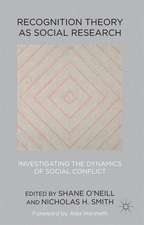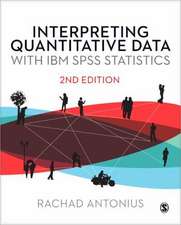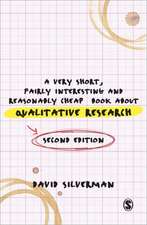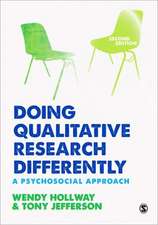Doing Quantitative Research in the Social Sciences: An Integrated Approach to Research Design, Measurement and Statistics
Autor Thomas R. Blacken Limba Engleză Paperback – 29 mar 1999
In a lively and accessible style, the student is introduced to researc design issues alongside statistical procedures and encouraged to develop analytical and decision-making skills.
| Toate formatele și edițiile | Preț | Express |
|---|---|---|
| Paperback (1) | 388.29 lei 3-5 săpt. | +68.59 lei 6-12 zile |
| SAGE Publications – 29 mar 1999 | 388.29 lei 3-5 săpt. | +68.59 lei 6-12 zile |
| Hardback (1) | 1604.79 lei 6-8 săpt. | |
| SAGE Publications – 29 mar 1999 | 1604.79 lei 6-8 săpt. |
Preț: 388.29 lei
Nou
Puncte Express: 582
Preț estimativ în valută:
74.30€ • 79.45$ • 61.95£
74.30€ • 79.45$ • 61.95£
Carte disponibilă
Livrare economică 28 martie-11 aprilie
Livrare express 13-19 martie pentru 78.58 lei
Preluare comenzi: 021 569.72.76
Specificații
ISBN-13: 9780761953531
ISBN-10: 0761953531
Pagini: 768
Ilustrații: black & white illustrations
Dimensiuni: 189 x 246 x 41 mm
Greutate: 1.44 kg
Ediția:1
Editura: SAGE Publications
Colecția Sage Publications Ltd
Locul publicării:London, United Kingdom
ISBN-10: 0761953531
Pagini: 768
Ilustrații: black & white illustrations
Dimensiuni: 189 x 246 x 41 mm
Greutate: 1.44 kg
Ediția:1
Editura: SAGE Publications
Colecția Sage Publications Ltd
Locul publicării:London, United Kingdom
Recenzii
`There is much that is excellent about this book. If all educational researchers had studied it thoroughly, especially the sections on research design, representative samples and confounding variables, then there might be less publication of sweeping statements based on insufficient evidence' - British Educational Research Journal
Cuprins
PART ONE: INTRODUCTION TO RESEARCH DESIGN
The Nature of Enquiry
Beginning the Design Process
Initial Sources of Invalidity and Confounding
Basic Designs
Identifying Populations and Samples
Additional Sources of Confounding by the Measurement Process and Interactions
Refining the Designs
PART TWO: MEASUREMENT DESIGN
Principles of Measurement and Collecting Factual Data
Measuring Attitudes, Opinions and Views
Measuring Achievement
Evaluating Data Quality
Determining Instrument Reliability and Validity
PART THREE: TURNING DATA INTO INFORMATION USING STATISTICS
Descriptive Statistics Using a Spreadsheet
Probability and Statistical Significance
Power, Errors and Choosing a
PART FOUR: EX POST FACTO, EXPERIMENTAL AND QUASI-EXPERIMENTAL DESIGNS: PARAMETRIC TESTS
Comparing Two Groups
<i>t</i>-Test
One-Way Analysis of Variance
Factorial Designs
Randomized Block Designs and Analysis of Covariance
PART FIVE: NONPARAMETRIC TESTS: NOMINAL AND ORDINAL VARIABLES
Nonparametric Tests
One and Two Samples
Nonparametric Tests
Multiple and Related Samples
PART SIX: DESCRIBING NON-CAUSAL RELATIONSHIPS
Correlation and Association
Regression
The Nature of Enquiry
Beginning the Design Process
Initial Sources of Invalidity and Confounding
Basic Designs
Identifying Populations and Samples
Additional Sources of Confounding by the Measurement Process and Interactions
Refining the Designs
PART TWO: MEASUREMENT DESIGN
Principles of Measurement and Collecting Factual Data
Measuring Attitudes, Opinions and Views
Measuring Achievement
Evaluating Data Quality
Determining Instrument Reliability and Validity
PART THREE: TURNING DATA INTO INFORMATION USING STATISTICS
Descriptive Statistics Using a Spreadsheet
Probability and Statistical Significance
Power, Errors and Choosing a
PART FOUR: EX POST FACTO, EXPERIMENTAL AND QUASI-EXPERIMENTAL DESIGNS: PARAMETRIC TESTS
Comparing Two Groups
<i>t</i>-Test
One-Way Analysis of Variance
Factorial Designs
Randomized Block Designs and Analysis of Covariance
PART FIVE: NONPARAMETRIC TESTS: NOMINAL AND ORDINAL VARIABLES
Nonparametric Tests
One and Two Samples
Nonparametric Tests
Multiple and Related Samples
PART SIX: DESCRIBING NON-CAUSAL RELATIONSHIPS
Correlation and Association
Regression
Notă biografică
Descriere
In a lively and accessible style, the student is introduced to research design issues alongside statistical procedures and encouraged to develop analytical and decision-making skills.














